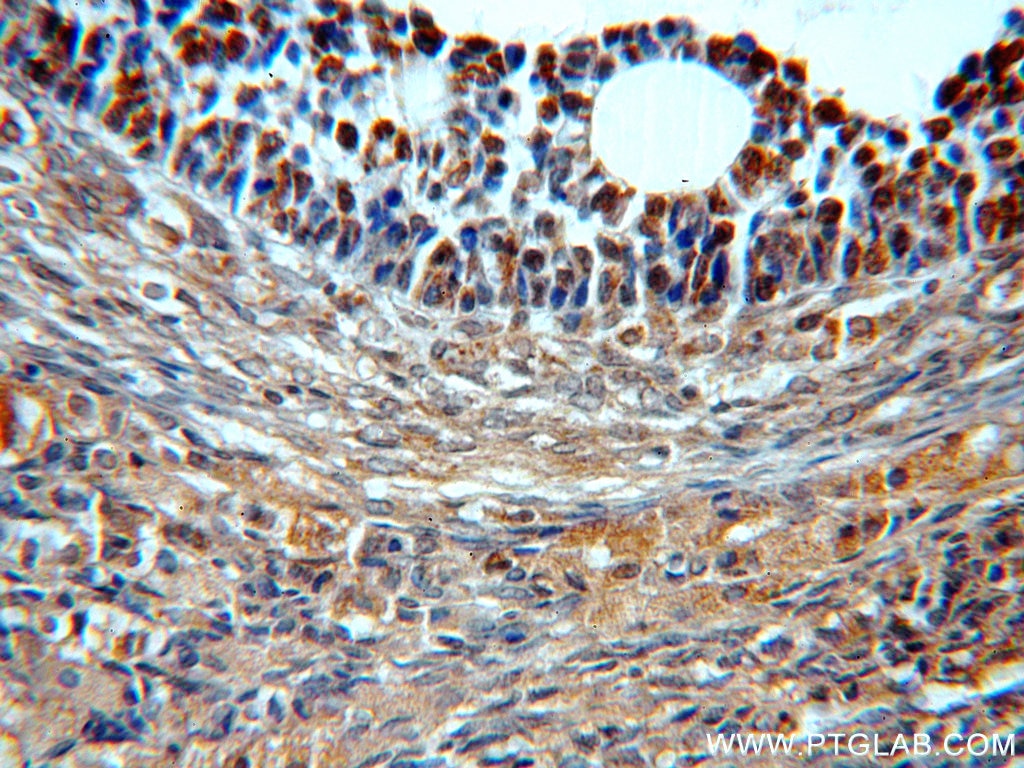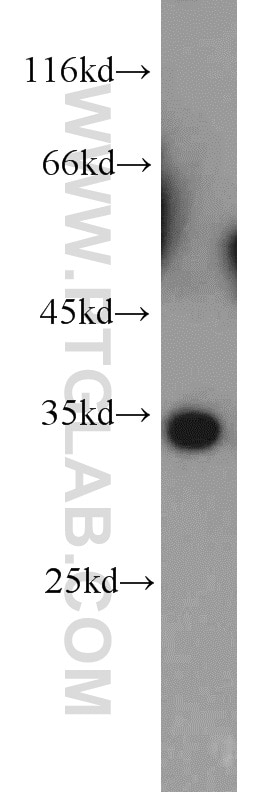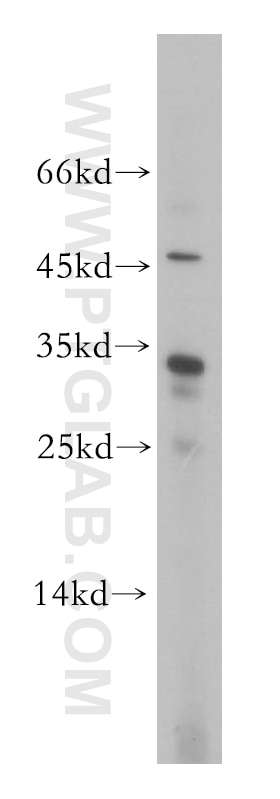Anticorps Polyclonal de lapin anti-BTG1
BTG1 Polyclonal Antibody for IHC, ELISA
Hôte / Isotype
Lapin / IgG
Réactivité testée
Humain, rat, souris
Applications
WB, IF, IHC, ELISA
Conjugaison
Non conjugué
N° de cat : 14879-1-AP
Synonymes
Galerie de données de validation
Applications testées
| Résultats positifs en IHC | tissu de cancer de la thyroïde humain, tissu de lymphome humain il est suggéré de démasquer l'antigène avec un tampon de TE buffer pH 9.0; (*) À défaut, 'le démasquage de l'antigène peut être 'effectué avec un tampon citrate pH 6,0. |
Dilution recommandée
| Application | Dilution |
|---|---|
| Immunohistochimie (IHC) | IHC : 1:50-1:500 |
| It is recommended that this reagent should be titrated in each testing system to obtain optimal results. | |
| Sample-dependent, check data in validation data gallery | |
Applications publiées
| WB | See 4 publications below |
| IHC | See 3 publications below |
| IF | See 1 publications below |
Informations sur le produit
14879-1-AP cible BTG1 dans les applications de WB, IF, IHC, ELISA et montre une réactivité avec des échantillons Humain, rat, souris
| Réactivité | Humain, rat, souris |
| Réactivité citée | Humain, souris |
| Hôte / Isotype | Lapin / IgG |
| Clonalité | Polyclonal |
| Type | Anticorps |
| Immunogène | BTG1 Protéine recombinante Ag6651 |
| Nom complet | B-cell translocation gene 1, anti-proliferative |
| Masse moléculaire calculée | 19 kDa |
| Numéro d’acquisition GenBank | BC064953 |
| Symbole du gène | BTG1 |
| Identification du gène (NCBI) | 694 |
| Conjugaison | Non conjugué |
| Forme | Liquide |
| Méthode de purification | Purification par affinité contre l'antigène |
| Tampon de stockage | PBS avec azoture de sodium à 0,02 % et glycérol à 50 % pH 7,3 |
| Conditions de stockage | Stocker à -20°C. Stable pendant un an après l'expédition. L'aliquotage n'est pas nécessaire pour le stockage à -20oC Les 20ul contiennent 0,1% de BSA. |
Informations générales
BTG1 is a member of the TOB/BTG family of proteins known to inhibit cell proliferation and negatively regulate the cell cycle (PMID: 25017022). It is strongly expressed in quiescent cells (maximal in the G0/G1 phase) and down-regulated as the cells enter the growth cycle (PMID: 1373383). BTG1 protein is localized in cytoplasm and nucleus, and can interact with CAF1 and PRMT1 (PMID: 1113675, 9712883, 26622543). The aberration of BTG1 expression is associated with B-cell lymphocytic leukemia, and may serve as a diagnostic indicator and prognostic marker of thyroid carcinoma (PMID: 2069907, 25017022).
Protocole
| Product Specific Protocols | |
|---|---|
| IHC protocol for BTG1 antibody 14879-1-AP | Download protocol |
| Standard Protocols | |
|---|---|
| Click here to view our Standard Protocols |
Publications
| Species | Application | Title |
|---|---|---|
Oncotarget BTG1 expression correlates with pathogenesis, aggressive behaviors and prognosis of gastric cancer: a potential target for gene therapy. | ||
Front Oncol BTG1 Overexpression Might Promote Invasion and Metastasis of Colorectal Cancer via Decreasing Adhesion and Inducing Epithelial-Mesenchymal Transition. | ||
Front Oncol Development and validation of a combined hypoxia and ferroptosis prognostic signature for breast cancer | ||
Int J Mol Sci BTG1 expression correlates with the pathogenesis and progression of ovarian carcinomas. | ||
J Cell Physiol Long noncoding RNA DGCR5 suppresses gastric cancer progression by acting as a competing endogenous RNA of PTEN and BTG1. | ||
Mol Med Rep Exosomal microRNA-301a-3p promotes the proliferation and invasion of nasopharyngeal carcinoma cells by targeting BTG1 mRNA |










